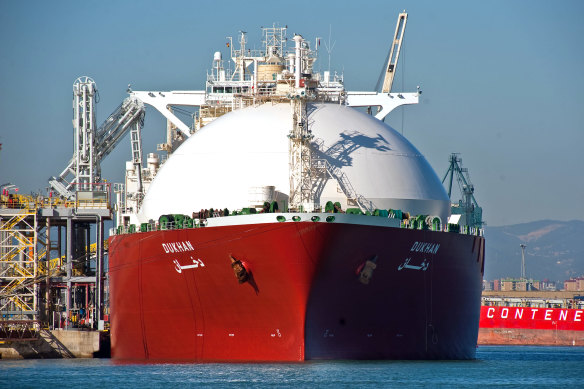By Nick Toscano
Energy giant Woodside says setting up floating gas-import terminals in south-eastern Australia may be the only option left to prevent a domestic gas crisis this decade as old production fields in Bass Strait rapidly dry up with scant new supplies to replace them.
Although vast amounts of gas produced in Queensland are exported overseas, authorities have been dialling up warnings that homes and businesses in Victoria, NSW and South Australia are heading for a shortage of the fossil fuel in as little as three years unless urgent measures are taken.

East coast Australia is running out of gas and we are left with little option but to import it, either from ourselves or overseas.Credit: Xabier Mikel Laburu
Instances of surging demand on cold winter days – when households crank up their heaters – could lead to shortages and price spikes hitting even sooner, the Australian Competition and Consumer Commission (ACCC) warns.
Woodside chief executive Meg O’Neill said proposals to begin east-coast imports of liquefied natural gas (LNG) from other states or overseas, and convert them back into vapour, were among the best options remaining to plug the looming supply gaps in time.

Woodside boss Meg O’Neill.Credit: Trevor Collens
“LNG import opportunities … are probably the most prospective ways to meet demand needs,” O’Neill said.
The most advanced plan for gas imports in the south-east is the Port Kembla LNG terminal, being built by Andrew and Nicola Forrest’s Squadron Energy near Wollongong. The project is nearly complete, but is yet to strike long-term customer offtake agreements to underpin its launch.
Another is Viva Energy’s proposal for a terminal at its Geelong oil refinery on Corio Bay, which is still undergoing assessment for environmental approval.
Although gas is a key source of planet-warming carbon dioxide and methane emissions, it remains widely used in heating, cooking, power generation and manufacturing processes across the nation.
Concerns about supplies of the fuel running short have been building as Woodside and ExxonMobil’s jointly owned Gippsland Basin operations in Bass Strait – the biggest source of east-coast gas – have entered a period of rapid decline.
O’Neill said all Gippsland Basin gas was sold domestically, and the joint venture was investing in new ways to eke out as much extra gas as they could from their existing fields. This included adding compression facilities on one of its platforms to enable access to additional reserves from its Kipper field.
“But it’s the tip of the iceberg,” she said. “I do think to maintain seasonal gas demand in Victoria something like LNG, with its flexible capacity, is going to be important.”
Woodside is Australia’s largest oil and gas producer, with operations spanning Western Australia, eastern Australia, Africa and the Americas. O’Neill’s comments come as the company reported a 21 per cent lift in sales revenue for the September quarter to $US3.8 billion on the back of record quarterly production volumes following the ramp-up of its Sangomar oil field in Senegal.
The strong results, which beat analysts’ forecasts, were also underpinned by strong performance at its WA operations, RBC Capital Markets analyst Gordon Ramsay said. “Woodside’s production operations ran very well, with Pluto and North West Shelf LNG reliability at 99 per cent over the quarter,” he said.
The prospect of beginning LNG imports in south-eastern Australia is facing resistance from conservation groups, who fear it will set back Australia’s climate ambitions by entrenching the use of harmful fossil fuels.
Opponents also say it is absurd to consider starting up imports given Australia is one of the largest global LNG exporters behind the United States.
Rather than bring in additional gas supplies, they say, more should be done to hold back gas destined for the export market, and accelerate programs to reduce household gas demand by encouraging the switch to cleaner electricity.
Policies banning gas hook-ups in new Victorian residential buildings and encouraging people to switch gas appliances to electric alternatives have successfully driven down long-term gas demand forecasts.
However, the Australian Energy Market Operator (AEMO) has calculated that the shift is not happening fast enough to avert the threat of shortfalls.
Without new ways to offset declining Bass Strait production, local supplies are running dangerously short, especially in winter.
Although Australia is a major LNG exporter, large volumes of Queensland gas production are already locked into long-term export contracts, while pipeline limitations restrict how much gas can flow south into Victoria and NSW on days of heavy winter heating demand, and gas from Western Australia cannot be transported east.
The Business Briefing newsletter delivers major stories, exclusive coverage and expert opinion. Sign up to get it every weekday morning.
correction
A previous version of this article stated that the Port Kembla LNG terminal, being built by Andrew and Nicola Forrest’s Squadron Energy, was near Newcastle. The terminal is near Wollongong.